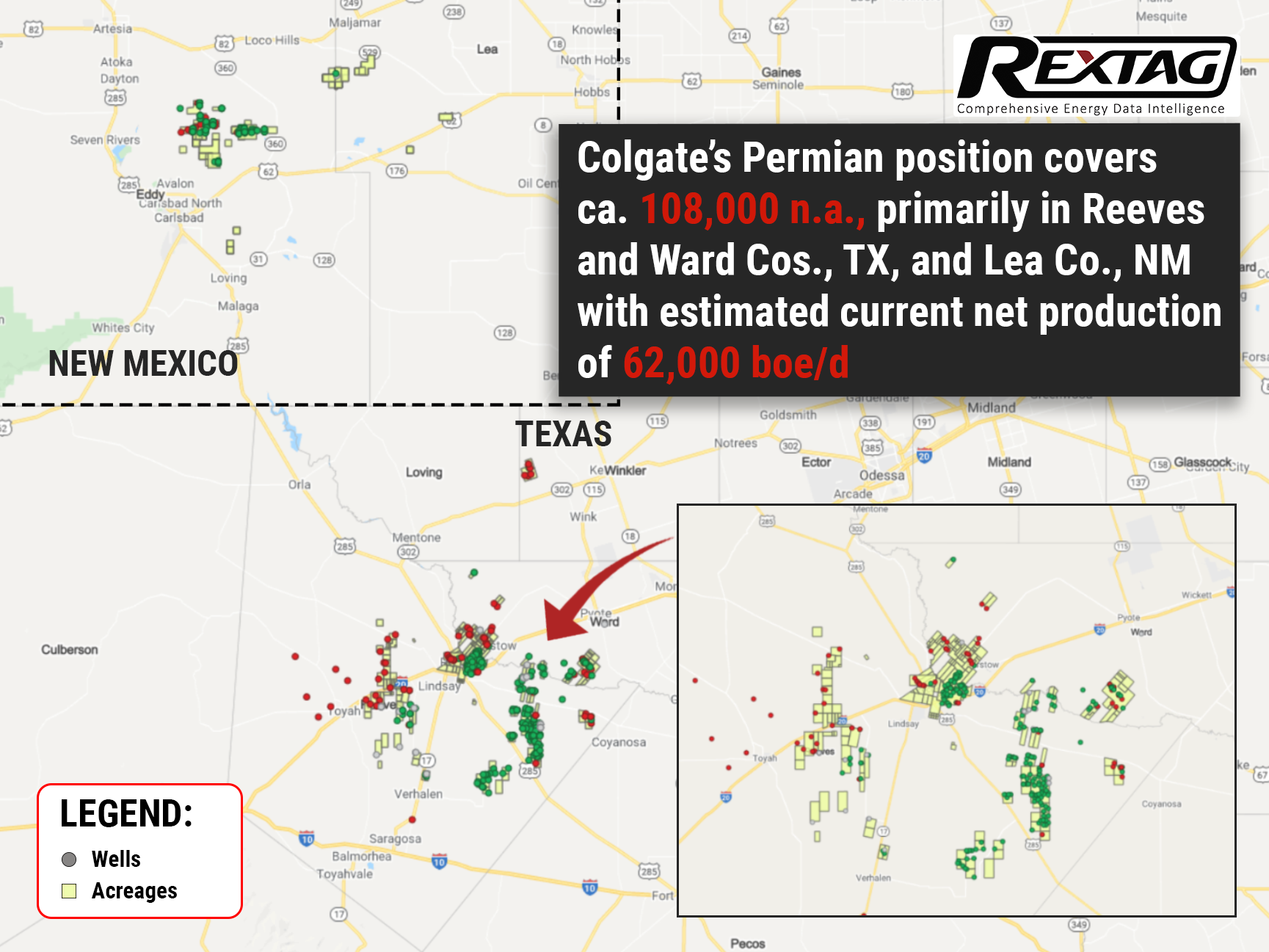Comprehensive Energy Data Intelligence
Information About Energy Companies, Their Assets, Market Deals, Industry Documents and More...
Colgate Energy's owners are planning to go public
01/19/2022
A four-year-old “IPO silence” from the Permian Bains’ operators is about to be broken: Colgate Energy Partners III LLC is reportedly planning to float the shale oil producer on the stock market. This would be the first major IPO for a U.S. oil producer since 2017.
Colgate Energy is a privately held oil and natural gas company based in Midland, Texas. Founded in 2015 with support from Pearl Energy Investments and NGP, the company made several noteworthy acquisitions this year that have significantly boosted its position in the Permian's Delaware Basin.
The move is likely motivated by a rise in energy prices, as economies emerge from pandemic lockdowns caused by COVID-19, resulting in attractive corporate valuations after years of underperformance in the oil patch.
According to sources, in an IPO slated for the middle of 2022, Pearl Energy Investments and NGP, the companies that own Colgate Energy Partners III, are partnering with Credit Suisse Group AG on getting the company ready. And while the numbers pertaining to the valuation of the IPO are not disclosed, Reuters as well as our own sources speculated that the sum could approach $5 billion, including debt.
Colgate may also explore the possibility of selling its business. However, nothing is finalized yet and the company could also continue to operate independently as a private company with strong cash flow.
Following Vine Energy's IPO earlier in 2021, the IPO would be the first major offering in the Permian Basin since Jagged Peak Energy's IPO in January 2017.
Meanwhile, Colgate has an estimated net production of 62,000 boe/d in the Permian Basin, pending a planned acquisition announced in early November, with a position covering approximately 108,000 net acres mainly within Reeves and Ward counties in Texas and Lea County in New Mexico.
The company expects to close its acquisition in the first quarter of 2022. About 22,000 net acres were acquired directly from the seller in an undisclosed deal worth $190 million in New Mexico's Eddy and Lea counties, directly offsetting Colgate's existing holding.
Furthermore, the company has already completed two major acquisitions in the past six months: Colgate purchased Luxe Energy from Occidental Petroleum Corp. in June, followed by the acquisition of Reeves and Ward County acreage from Occidental Petroleum in July for $508 million in cash.
Investors’ confidence in the sector is returning as U.S. crude prices hit their highest in seven years late last year S&P energy index delivered roughly twice the return of the S&P 500 in 2021.
The Permian Basin, in particular, is set to achieve record output in January, thanks to supporting commodity prices for companies such as Colgate.
If you are looking for more information about energy companies, their assets, and energy deals, please, contact our sales office mapping@hartenergy.com, Tel. 619-349-4970 or SCHEDULE A DEMO to learn how Rextag can help you leverage energy data for your business.
$7 Billion Merger of Colgate and Centennial, the 2 Largest Permian Operators
![$data['article']['post_image_alt']](https://images2.rextag.com/public/blog/68Blog_colgate_centennial_merger_announced_05_2022.png)
Despite the circulating rumors concerning Colgate’s attempt to launch an IPO, on May 19 the company decided to combine with Centennial Resource Development Inc. This merger of equals is estimated at $7 billion and will found the biggest pure-play E&P company in the Delaware Basin of the Permian. The transformative combination essentially enlarges companies’ potential and hastens the growth across all financial and operating metrics. According to Centennial CEO Sean Smith, the combined company is anticipated to furnish shareholders with quickened capital return program due to a fixed dividend coupled with a share repurchase plan. Due to a recent report, the merger would increase production 7%, to 145,000 boe/d by the fourth quarter would further ratchet up next year. By third-quarter 2023, the company predicted 160,000 boe/d based on a drilling program of 140 wells per year. Colgate Energy was reported to be getting an IPO last December that sources said would value the company at approximately $4 billion. The combined company will have over 15-years of drilling inventory, assuming its current drilling pace, the companies will produce over $1 billion of free cash flow in 2023 at current strip prices.
Look At The Future Of American And Appalachian Gas Production
![$data['article']['post_image_alt']](https://images2.rextag.com/public/blog/Look-At-The-Future-Of-American-And-Appalachian-Gas-Production.png)
The crux of the matter is rather simple: productivity gains of local energy operators have been stable not only because they are drilling better acreage, but also because players finally realized capital efficiency gains. And even if some new obstacles impede Appalachia's growth at the same rate as the Permian or Haynesville, it does not detract from the value of the Marcellus and Utica basins. The Appalachians will still be the top producers at a very competitive pace as long as commercial inventory exists. After all, as long as there is commercial inventory, somebody will have to drill.
![$data['article']['post_image_alt']](https://images2.rextag.com/public/blog/328_Blog_Why Are Oil Giants Backing Away from Green Energy Exxon Mobil, BP, Shell and more .jpg)
As world leaders gather at the COP29 climate summit, a surprising trend is emerging: some of the biggest oil companies are scaling back their renewable energy efforts. Why? The answer is simple—profits. Fossil fuels deliver higher returns than renewables, reshaping priorities across the energy industry.
![$data['article']['post_image_alt']](https://images2.rextag.com/public/blog/327_Blog_Oil Market Outlook A Year of Growth but Slower Than Before.jpg)
The global oil market is full of potential but also fraught with challenges. Demand and production are climbing to impressive levels, yet prices remain surprisingly low. What’s driving these mixed signals, and what role does the U.S. play?
![$data['article']['post_image_alt']](https://images2.rextag.com/public/blog/326_Blog_USA Estimated Annual Rail CO2 Emissions 2035.jpg)
Shell overturned a landmark court order demanding it cut emissions by nearly half. Is this a victory for Big Oil or just a delay in the climate accountability movement?